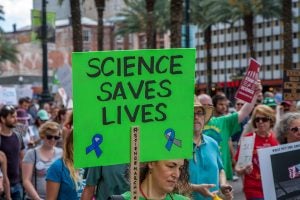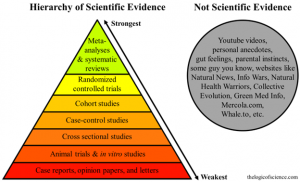What do science communication and agricultural communication have in common?
A lot actually, as science and agriculture overlap in so many ways. Agriculture is a field where science and innovation meet tradition and passion. It’s a dynamic equilibrium — a balancing act, which makes agricultural communications quite unique. Those of us in ag can learn and build from the challenges of science communication, which mirror our own struggles.
One of the biggest hurdles in any type of science communications — whether that be in the medical, climate, or agricultural fields — is denialism. Science denialism is the rejection of facts and scientific consensus in favor of controversial or radical ideas.

If the pandemic has taught us anything, it would be about the prevalence and damage misinformation can cause. So and so says one thing. This expert says another, but this is different from what was said last year, and on and on. How do we even know what’s true anymore? For help detecting internet pseudoscience, see this article.
An atmosphere of confusion and distrust is ripe for the spread of misinformation. This can cause real harm, whether that be the further spread of a contagious disease or parents removing entire food groups from their children’s diets based on fear-mongering.
Those of us in agriculture are very familiar with the consequences of misinformation, and many consumers are disconnected from how their food is produced. The general lack of knowledge and familiarity with modern agriculture along with pseudoscience is the root of many anti-agriculture ideologies: from anti-GMO to animal rights activist groups.
It’s definitely not a matter of intelligence. It can be very difficult to separate the facts from the fiction without much background knowledge or familiarity on the topics at hand.
When you’re are unacquainted with agriculture, it’s easier to believe misinformation about ag. In the same way, a lack of understanding about science can lead to science denialism, distrust, and further misinformation. Science is more than just fun facts about how the world works. It’s a continuous structured process of discovery. It relies on observation, experimentation, and the testing of hypotheses against the evidence gathered.
There is also a lot of money to be made off of fear and misinformation. “Organic” and “natural” branding is a $350 billion business, and by convincing people there is something wrong with modern agriculture or conventional food — livestock care and more — it quickly leads to greater profits for certain food corporations or more donations to vegan animal-rights groups.
Scientific consensus is not simply a collection of irrefutable facts or experts who agree about something. It’s specifically the evidence and data that agree. This isn’t just one study. It’s hundreds. There isn’t some secret society of scientists debating then voting to agree. It’s a slow, painstaking process of hundreds of independent studies being published within a topic. It also depends on the quality and quantity of the data, critical peer-review, and the repetition of results by other scientists. The data is scrutinized by many scientists within that specific field with many years of accumulated knowledge and expertise. This is based on many years and decades of actual research, not just a few days of looking something up on Google.
Science is not simply a collection of facts — it evolves and progresses over time and more evidence is examined. To overturn scientific consensus, you need many years and hundreds of peer-reviewed and critically analyzed independent scientific studies with a higher quantity or quality of evidence. It can be overturned, but not by simple debate or anecdotes. Cherry-picking studies that agree with our own biases or other logical fallacies don’t fulfill this requirement. One study does not make a scientific consensus.
Not all studies are created equal. Sometimes bad science occurs — and is even published. Whether an outdated method was used or too small of sample a size. In some cases, the conclusions drawn by the research team may not fit the data or may overstate the data. Confounding variables or using cell or animal models to draw definitive conclusions about humans can contribute to this as well. That’s why it’s important to fully read the study and see if it makes sense.

Poor reporting, misleading headlines, celebrities, and people trying to sell you something all contribute to the spread of misinformation. They may exaggerate the claims of a study or misinterpret it all together (sometimes intentionally, sometimes not). Media can spread bad science, even after it has been retracted and refuted. It’s easy to remember the sensational headlines, but refuted studies and retractions don’t tend to get as much attention.
For example, a 2006 United Nations Report claimed that livestock was responsible for 18 percent of global emissions, supposedly more than transportation. This shocking figure was picked up and spread by media and anti-agriculture activists alike. To compare, the U.S. EPA states that in 2019 all of agriculture made up about 10 percent of national GHG emissions, with transportation, electricity, and industry making up 29 percent, 25 percent percent, and 23 percent respectively. Livestock make up 4 percent of that 10, with cattle accounting for just over 2 percent.
The U.N.’s report was later refuted when scientists, such as air quality expert Dr. Frank Mitloehner from the University of California, Davis, found that the study used a flawed methodology that considered the entire life cycle of livestock production and compared it to merely tailpipe emissions from transportation (the impact of aspects such as vehicle, infrastructure, or fuel production hadn’t been counted in the U.N. transportation data).
Even though the U.N. report has been thoroughly refuted and retracted, the myths spawned from it continue to spread today.
Many of the misconceptions we deal with in the agriculture space are connected to a societal disconnect from science. This disconnect can make science and scientists feel inaccessible to the general public. This reflects the same disconnect of farmers and other agriculturalists may feel. This disconnect breeds distrust in authority and expertship, not just in science, but in agriculture. However, too much skepticism can be as damaging as too much trust.
In both science and agricultural communication, we don’t just need to communicate about facts and knowledge. We also need to address the fundamental lack of connections and trust. It isn’t merely educating or telling our story, it’s about connecting with a solid base of knowledge. To learn more see this article.
Michelle Miller, the Farm Babe, is a farmer, public speaker and writer who has worked for years with row crops, beef cattle, and sheep. She believes education is key in bridging the gap between farmers and consumers.



